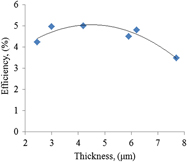Crossref Citations
This article has been cited by the following publications. This list is generated based on data provided by
Crossref.
Yune, Jeremy H.
Karatchevtseva, Inna
Triani, Gerry
Wagner, Klaudia
and
Officer, David
2013.
A study of TiO2 binder-free paste prepared for low temperature dye sensitized solar cells – ERRATUM.
Journal of Materials Research,
Vol. 28,
Issue. 4,
p.
657.
Bosch-Jimenez, Pau
Yu, Youhai
Lira-Cantu, Mónica
Domingo, Concepción
and
Ayllón, José A.
2014.
Solution processable titanium dioxide precursor and nanoparticulated ink: Application in Dye Sensitized Solar Cells.
Journal of Colloid and Interface Science,
Vol. 416,
Issue. ,
p.
112.
Wang, Xiaoxu
Xi, Min
Zheng, Fan
Ding, Bin
Fong, Hao
and
Zhu, Zhengtao
2015.
Reduction of crack formation in TiO 2 mesoporous films prepared from binder-free nanoparticle pastes via incorporation of electrospun SiO 2 or TiO 2 nanofibers for dye-sensitized solar cells.
Nano Energy,
Vol. 12,
Issue. ,
p.
794.
Yune, Jeremy H.
Karatchevtseva, Inna
Evans, Peter J.
Wagner, Klaudia
Griffith, Matthew J.
Officer, David
and
Triani, Gerry
2015.
A versatile binder-free TiO2 paste for dye-sensitized solar cells.
RSC Advances,
Vol. 5,
Issue. 37,
p.
29513.
Homola, Tomáš
Dzik, Petr
Veselý, Michal
Kelar, Jakub
Černák, Mirko
and
Weiter, Martin
2016.
Fast and Low-Temperature (70 °C) Mineralization of Inkjet Printed Mesoporous TiO2 Photoanodes Using Ambient Air Plasma.
ACS Applied Materials & Interfaces,
Vol. 8,
Issue. 49,
p.
33562.
Thirupathi, G
Kandula, Kumara Raja
Raavi, Sai Santosh Kumar
and
Asthana, Saket
2017.
The effect on electrical and luminescent properties in nanocrystalline Na0.5Bi0.5−xNdxTiO3.
Materials Research Express,
Vol. 4,
Issue. 9,
p.
095019.
Musazade, Elshan
Voloshin, Roman
Brady, Nathan
Mondal, Jyotirmoy
Atashova, Samaya
Zharmukhamedov, Sergey K.
Huseynova, Irada
Ramakrishna, Seeram
Najafpour, Mohammad Mahdi
Shen, Jian-Ren
Bruce, Barry D.
and
Allakhverdiev, Suleyman I.
2018.
Biohybrid solar cells: Fundamentals, progress, and challenges.
Journal of Photochemistry and Photobiology C: Photochemistry Reviews,
Vol. 35,
Issue. ,
p.
134.
Shamsudin, N.H.
Shafie, S.
Ab Kadir, M.Z.A.
Ahmad, F.
Sadrolhosseini, A.R.
Sulaiman, Y.
and
Chachuli, S.A.M.
2020.
Power conversion efficiency (PCE) performance of back-illuminated DSSCs with different Pt catalyst contents at the optimized TiO2 thickness.
Optik,
Vol. 203,
Issue. ,
p.
163567.
Shamsudin, N H
Shafie, S
Ab. Kadir, M Z A
Ahmad, F
Chachuli, S A M
and
Sulaiman, Y
2020.
I-V performance analysis of flexible back Illuminated Dye Sensitized Solar cells (DSSCS) with various platinum catalyst contents.
Journal of Physics: Conference Series,
Vol. 1432,
Issue. 1,
p.
012043.
Poh, S. C.
Ahmad, H.
Ting, C. H.
Tung, H. T.
and
Jun, H. K.
2021.
Performances of flexible dye‐sensitized solar cells fabricated with binder‐free nanostructure TiO2.
Journal of Materials Science: Materials in Electronics,
Vol. 32,
Issue. 9,
p.
12031.
Liu, Qin
and
Cheng, Cunxi
2021.
Facile construction of a polypyrrole–cobalt sulfide counter electrode for low-cost dye-sensitized solar cells.
RSC Advances,
Vol. 11,
Issue. 60,
p.
38146.
Dawo, Chandan
Hossain, Maimur
Iyer, Parameswar Krishnan
and
Chaturvedi, Harsh
2022.
UV Ozone based rapid low temperature fabrication of flexible dye sensitized solar cells.
Synthetic Metals,
Vol. 291,
Issue. ,
p.
117172.
Richhariya, Geetam
Meikap, Bhim Charan
and
Kumar, Anil
2022.
Review on fabrication methodologies and its impacts on performance of dye-sensitized solar cells.
Environmental Science and Pollution Research,
Vol. 29,
Issue. 11,
p.
15233.
Rahman, Md. Mahbubur
Kang, Hyeong Cheol
Yoo, Kicheon
and
Lee, Jae-Joon
2022.
Low-Temperature Chemical Sintered TiO2 Photoanodes Based on a Binary Liquid Mixture for Flexible Dye-Sensitized Solar Cells.
Journal of Electrochemical Science and Technology,
Vol. 13,
Issue. 4,
p.
453.
Zhou, Shengxing
Chen, Wenhao
Liu, Weiqing
Cao, Jiale
and
Yuan, Ligang
2024.
A study on using a binder-free TiO2 paste with sodium dodecylbenzene sulfonate addition to improve the performance of low-temperature DSSCs.
Solar Energy,
Vol. 274,
Issue. ,
p.
112553.
Putra, Kemal Lesmana Hidayat
Silmi, Nadiatus
Nugroho, Fairuz Gianirfan
Himmah, Suci Noerfaiqotul
Siddik, Muhamad Nur
Fauziah, Nenden
Steky, Fry Voni
Benu, Didi Prasetyo
Milana, Phutri
Yuliarto, Brian
and
Suendo, Veinardi
2024.
Fabrication of binder-free TiO2 P 25 films on flexible PET/ITO substrate for photoanode in dye-sensitized solar cells.
Optical Materials,
Vol. 154,
Issue. ,
p.
115690.
